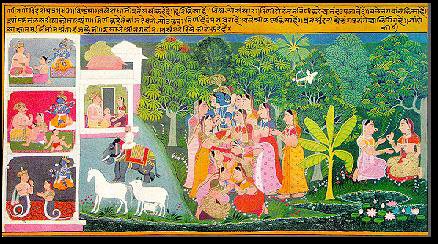Tweet

"Visvesa... krida kare hain."
The long conjointed phrases of the Sardula vikridita metrical pattern describe Hari through adjectives which fall upon each other. The artist is not only faithful to the meaning, but also to the metrical pattern. In the poem the poet used each word singly, with pauses; the artist followed the metrical structure. In this verse the poet portrays the universality of Krsna's love and its power to bring joy and bliss (ananda).
Appropriately the lines, "When He quickens all things To bestow bliss and joy on all mortals," stimulate the artist to show Krsna bestowing blessings on kings (upper left corner), on the people (left hand) and on animal and aquatic life (adjoining area with horses and elephants). Thus all categories of life and all levels of society are receivers of this joy. Each scene is placed in a demarcated area, but all are connected. The flow of the line is sustained pictorially, with remarkable success.
The next three lines of the stanza contain one long unbroken simile. The sinuous soft blue lotus limbs of Hari are entwined with the creeper-like formation of the bodies of the beautiful maidens of Braja. The blue body of Syama is the blue of the sky, and the divine lotus limbs are the life.
Jayadeva, the master of oceans of meaning, condenses a multitude of meanings into just three lines. The artist makes a heroic effort to express the plurality of meaning in pictorial terms. The body of Hari, blue, soft, and sinuous, is entwined, almost enmeshed so that it can hardly be distinguished from the several bodies of the gopis wound around Him.
This is as exact a visual realisation of the vocal poetry as would be possible. The fact that this entwined body is the very embodiment (murtiman) of the God of Love (manmatha) is brought out by the tiny, but conspicuously white figure of Kama amongst the trees. The foliage follows a creeper like pattern and flows in and out of this composite picture. A banana tree separates both these scenes from that of Radha and the sakhi, who are now placed in the right corner.
An analysis of these paintings perhaps will have made it clear that the integral relationship of the poetic and pictorial is the solid foundation of the visual composition. On one level, the paintings are pleasingly decorative and somewhat repetitive like Indian music and dance. On another level lies a whole universe of contextual plural meanings communicated only to an initiated spectator or hearer. In this respect they represent the continuity of an ancient tradition which demands an attuned heart.
As in any great creation, the reader, viewer, or hearer responds to the work at their own particular level of consciousness. A parallel phenomenon can be discerned in the principles of composition, and in the processes of communication in the sphere of music and dance. Understandably, not all the paintings of the set attain this level of comprehension or success in the power to communicate. This plate is a splendid example of this inextricable relationship.

